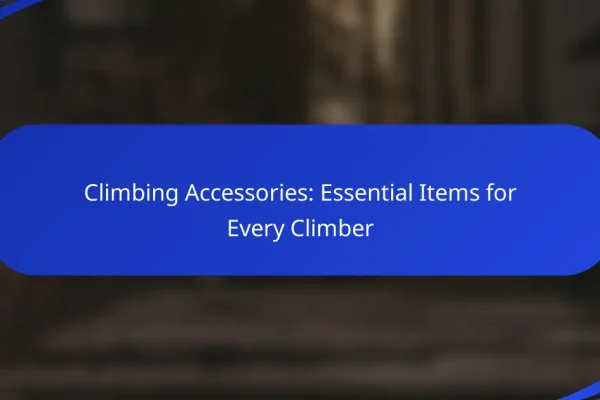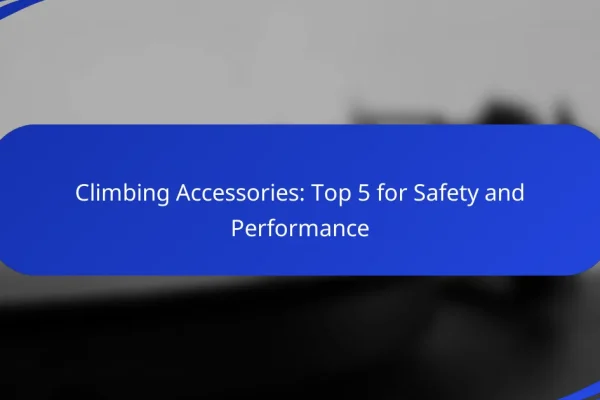What are the best climbing accessories for beginners?
The best climbing accessories for beginners include essential gear that enhances safety and performance. Key items like harnesses, shoes, chalk bags, carabiners, and belay devices are crucial for a successful start in climbing.
Climbing harnesses
A climbing harness is vital for safety, as it secures you to the rope and protects you during falls. Beginners should look for a harness that fits snugly but comfortably, with adjustable leg loops and a waist belt. Brands often offer sizing charts to help you find the right fit.
When choosing a harness, consider the type of climbing you will do. Sport climbing harnesses are typically lighter and more streamlined, while trad climbing harnesses may have additional gear loops for carrying equipment. Always check for safety certifications like UIAA or CE.
Climbing shoes
Climbing shoes are designed to provide grip and support on various surfaces. For beginners, a shoe with a moderate fit and a rubber sole is ideal, as it balances comfort and performance. Look for shoes that allow for some toe movement without being overly tight.
Consider trying on several pairs to find the best fit, as different brands have varying sizing. Shoes should feel snug but not painful, and you may want to choose a model with a softer rubber for better friction on indoor walls and beginner routes.
Chalk bags
Chalk bags help keep your hands dry, improving grip on holds. A good chalk bag should be easy to access and have a secure closure to prevent chalk spills. Look for one with a drawstring or a flap to keep chalk contained.
Many chalk bags come with a belt or clip for easy attachment to your harness. Beginners often prefer larger bags for easier access, while more experienced climbers might choose smaller, lighter options for minimalism.
Carabiners
Carabiners are essential for connecting various pieces of climbing gear. For beginners, a locking carabiner is recommended for safety, especially when belaying or rappelling. Look for carabiners that are lightweight yet durable, typically made from aluminum.
Consider the gate type as well; a screw-lock gate provides extra security, while a quick-lock gate allows for faster operation. It’s advisable to have a mix of both types for different climbing scenarios.
Belay devices
Belay devices are crucial for managing the rope during climbs. For beginners, an assisted-braking device is often recommended, as it provides extra safety by automatically locking the rope in case of a fall. Popular models include the Petzl GriGri and the Black Diamond ATC.
When selecting a belay device, ensure it is compatible with the rope diameter you plan to use. Most devices work well with a range of rope sizes, but always check the manufacturer’s specifications to avoid issues while climbing.
How to choose climbing accessories for outdoor climbing?
Choosing climbing accessories for outdoor climbing involves prioritizing safety, weight, and compatibility with existing gear. Assessing these factors ensures that you select equipment that enhances your climbing experience while keeping you secure.
Consider safety ratings
Safety ratings are crucial when selecting climbing accessories, as they indicate the reliability and durability of the gear. Look for equipment that meets recognized standards such as UIAA or CE, which ensure that the products have undergone rigorous testing.
Always check the manufacturer’s specifications for load limits and usage guidelines. Accessories like harnesses, carabiners, and ropes should have clear safety ratings to help you make informed choices.
Evaluate weight and portability
Weight and portability are essential considerations, especially for long climbs or multi-pitch routes. Lightweight accessories can significantly reduce fatigue and improve your overall performance.
When evaluating options, consider materials such as aluminum for carabiners or lightweight synthetic fibers for ropes. Aim for gear that balances durability with minimal weight, typically looking for products that weigh under a few hundred grams for optimal portability.
Check compatibility with gear
Ensuring compatibility with your existing climbing gear is vital for a seamless experience. Accessories like harnesses, helmets, and belay devices should work well with your ropes and carabiners.
Before purchasing, verify that the accessories fit together correctly and meet the specifications for your climbing style. For example, check that your belay device is compatible with the rope diameter you plan to use, which typically ranges from 8 to 11 mm.
What are the essential climbing accessories for sport climbing?
Essential climbing accessories for sport climbing include quickdraws, climbing ropes, and crash pads. These items enhance safety, efficiency, and performance while navigating climbing routes.
Quickdraws
Quickdraws are vital for sport climbing as they connect the climbing rope to the fixed protection points on the route. Typically, a quickdraw consists of two carabiners linked by a durable sling, allowing for smooth rope movement and reducing drag.
When selecting quickdraws, consider their length and weight. Shorter quickdraws are lighter and ideal for sport climbing, while longer ones can help reduce rope drag on overhanging routes. Aim for a mix of sizes to suit various climbing situations.
Climbing ropes
Climbing ropes are essential for safety and performance in sport climbing. Dynamic ropes, designed to stretch under load, are the preferred choice as they absorb the impact of falls, reducing the risk of injury.
When choosing a climbing rope, look for a diameter between 9.5 mm and 10.5 mm, balancing weight and durability. A length of 60 to 70 meters is common for sport climbing, allowing for versatility on different routes. Always check for UIAA certification to ensure safety standards are met.
Crash pads
Crash pads are crucial for bouldering, providing a protective landing surface when falling from heights. They come in various sizes and thicknesses, with larger pads offering more coverage and thicker pads providing better impact absorption.
When purchasing a crash pad, consider portability and ease of setup. Look for features like adjustable straps and foldable designs for convenient transport. A good rule of thumb is to have at least one large crash pad and a couple of smaller ones for added safety when bouldering.
What are the top brands for climbing accessories?
The leading brands for climbing accessories are Petzl, Black Diamond, and Scarpa. These companies are renowned for their quality, innovation, and reliability in the climbing community.
Petzl
Petzl is a French company known for its high-quality climbing gear, including harnesses, helmets, and headlamps. Their products are designed with safety and functionality in mind, making them a favorite among climbers of all levels.
When choosing Petzl gear, consider their extensive range of harnesses, which cater to various climbing styles, from sport climbing to mountaineering. Look for features like adjustable leg loops and gear loops for added convenience.
Black Diamond
Black Diamond is an American brand that specializes in climbing, skiing, and mountain sports equipment. Their climbing accessories, such as carabiners, cams, and protection devices, are widely used and trusted by professionals and enthusiasts alike.
Black Diamond products often emphasize durability and performance. For instance, their carabiners come in various shapes and sizes, allowing climbers to select the best option for their specific needs, whether it’s for sport climbing or trad climbing.
Scarpa
Scarpa is an Italian brand primarily known for its climbing shoes and mountaineering boots. Their footwear is designed to provide excellent fit, comfort, and performance on the rock.
When selecting Scarpa climbing shoes, consider the type of climbing you will be doing. Scarpa offers options for beginners to advanced climbers, with features like aggressive downturned shapes for sport climbing and more relaxed fits for all-day wear on multi-pitch routes.
What are the best climbing accessories for bouldering?
The best climbing accessories for bouldering include bouldering pads, climbing chalk, and climbing tape. Each of these items enhances safety, performance, and comfort while climbing.
Bouldering pads
Bouldering pads, or crash pads, are essential for protecting climbers from falls. They come in various sizes and thicknesses, typically ranging from 3 to 6 inches, with larger pads offering more coverage and cushioning.
When choosing a bouldering pad, consider weight and portability, especially if you plan to hike to climbing locations. Look for features like durable materials, secure closures, and easy transport options, such as shoulder straps or handles.
Climbing chalk
Climbing chalk helps improve grip by reducing moisture on the hands. Most climbers use magnesium carbonate chalk, which is effective in keeping hands dry during climbs.
Chalk comes in various forms, including loose chalk, chalk balls, and liquid chalk. Loose chalk is popular for its versatility, while chalk balls minimize mess and waste. Choose based on your climbing style and personal preference.
Climbing tape
Climbing tape is used to protect fingers and hands from abrasions and injuries. It can also be used to secure gear or repair equipment temporarily. Look for high-quality athletic tape that adheres well and provides adequate support.
When applying climbing tape, ensure it is snug but not too tight to restrict circulation. Common areas to tape include fingers, knuckles, and wrists, especially if you are prone to injuries in these spots.
How to maintain climbing accessories?
Maintaining climbing accessories is essential for safety and performance. Regular checks and proper care can extend the life of gear such as harnesses, ropes, and carabiners.
Inspecting gear regularly
Regular inspections of climbing accessories should be performed before and after each use. Look for signs of wear, such as fraying on ropes, corrosion on carabiners, or cracks in harnesses. A good practice is to follow a checklist to ensure no detail is overlooked.
For ropes, check for any flat spots or cuts, while carabiners should be examined for smooth operation and any signs of deformation. If any gear shows significant wear, it should be retired and replaced immediately.
Cleaning climbing accessories
Cleaning your climbing gear is crucial to maintain its integrity and performance. Ropes can be washed in lukewarm water with mild soap, while harnesses and slings should be hand-washed to avoid damage. Always follow the manufacturer’s instructions for specific cleaning recommendations.
After cleaning, ensure that all items are thoroughly dried before storage to prevent mildew and degradation. Avoid using harsh chemicals or machine washing, as these can weaken the materials.
Storing climbing gear properly
Proper storage of climbing accessories helps prevent damage and prolongs their lifespan. Store ropes in a cool, dry place away from direct sunlight, and avoid folding them tightly to prevent kinks. Harnesses and slings should be kept in a breathable bag to avoid moisture buildup.
For carabiners, store them in a designated container to prevent scratches and ensure they remain functional. Regularly check stored gear for any signs of damage or deterioration, especially if it has been unused for an extended period.












